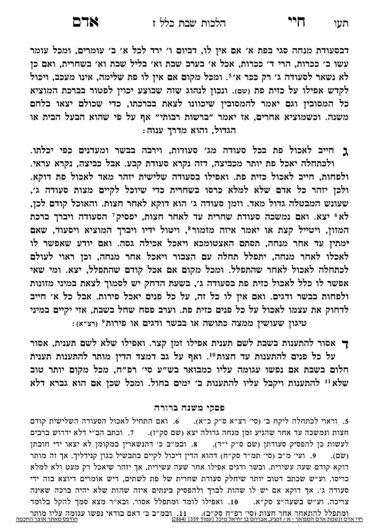The current series, which will cover seudos Shabbos and fasting on Shabbos, is available for sponsorship. Please contact Rabbi Reingold for more information.
We are continuing siman 3, discussing the halachos of seudah shlishis, the Chayei Adam writes that preferably, one should fulfill their chiyuv of seudah shlishis after mincha. We have learned that Chazal limit a person eating meals before mincha out of concern that they forget about davening. We rely on the opinion of Tosfos and the Rosh that the issur only applies to a large meal and when it is close to mincha ketana. On the other hand, the Rif and Rambam hold that even a small seuda cannot be consumed close to mincha ketana. Close is defined as thirty minutes before, which would mean beginning at chatzos. Since this is an issur derabanan, we rely on the lenient opinion of Tosfos and the Rosh. Nevertheless, if one is able to avoid the issue and daven mincha between the meals, it is certainly preferable. Additionally, the Arizal brings that kabbalistically, seudah shlishis should be eaten after mincha. Therefore, the Rema brings that one should wait until after mincha. Nevertheless, the Chayei Adam writes that if one ate before davening mincha, they are yotzei.
Next, the Chayei Adam will discuss one who cannot eat bread for seudah shlishis. Beforehand, we will discuss a few more points regarding the proper time for seudah shlishis:
The Chayei Adam wrote that if one’s meal extended from before chatzos until after chatzos, if they break up their meal with birchas hamazon and a break they can count it as two seudos. In truth, the zman for seuda shlishis is from mincha gedolah, which is a half hour after chatzos. It is a machlokes whether the half hour is 30 minutes in standard time, or half an hour in sha’os zmanios (halachic hours). Many poskim assume it is 30 minutes and one can rely on that.
On the other end of the spectrum, one should make sure to wash before shkia. When we learned about tosefes Shabbos, we learned about the opinion of the Taz, that even though one can add tosefes Shabbos, the seudos must take place on Shabbos itself. Minimally, one should eat a kezayis when it is certainly Shabbos. Flipping it around over here, one should be careful to eat a kezayis of bread before sunset.
Preferably, one should eat a k’beiah of bread, but minimally they are yotzei with a kezayis. It is important to note that regarding netilas yadayim, there is a machlokes Gra and Shulchan Aruch regarding the minimum amount of bread which requires netilas yadayim. According to the Gra, if a person plans to eat a kezayis they should wash with a bracha. According to the Shulchan Aruch, the bracha is only recited if one eats a k’beiah. If so, according to the Shulchan Aruch, if one only plans to eat a kezayis, they cannot make a bracha on their washing.
Practically, we wash even for less than a kezayis, but we do not make the bracha of al netilas yadayim unless one plans to eat a k’beiah.
Summary
Lechatchilla, one should daven mincha before seudah shelishis, but they are yotzei if they eat beforehand.
The earliest time for seuda shlishis is the zman of mincha gedolah, 30 standard minutes after chatzos
Lechatchilla, one should eat a kezayis of bread before shkia, even if they plan to continue into bein hashmashos.
The bracha of al netilas yadayim is only recited if one plans to east a k’beiah.



